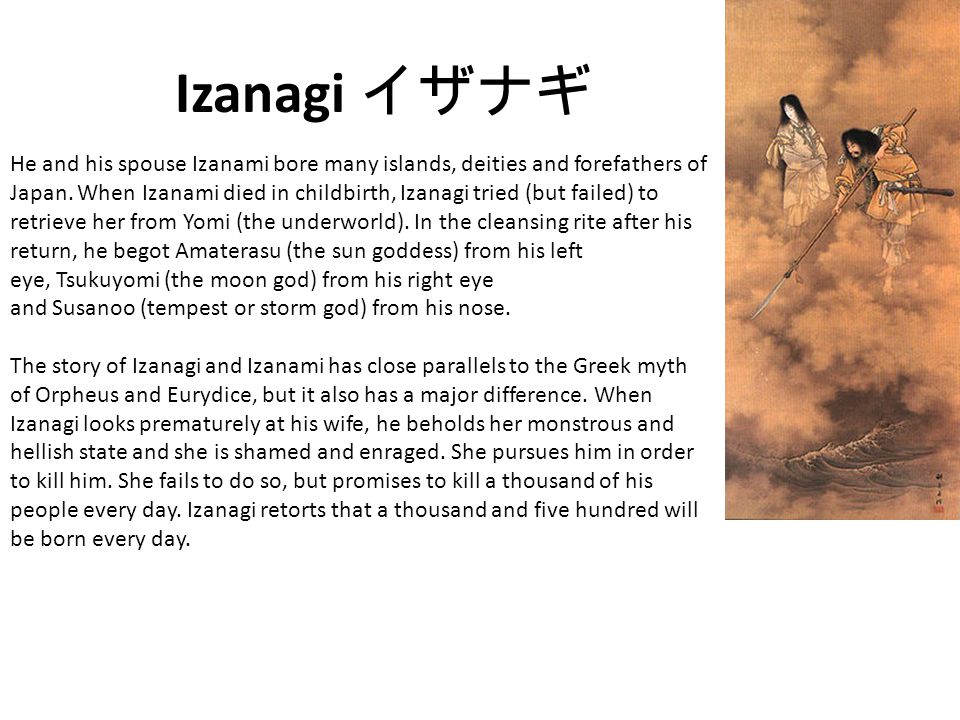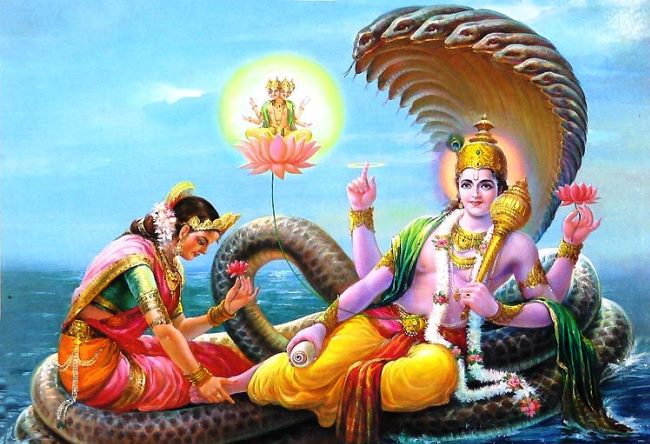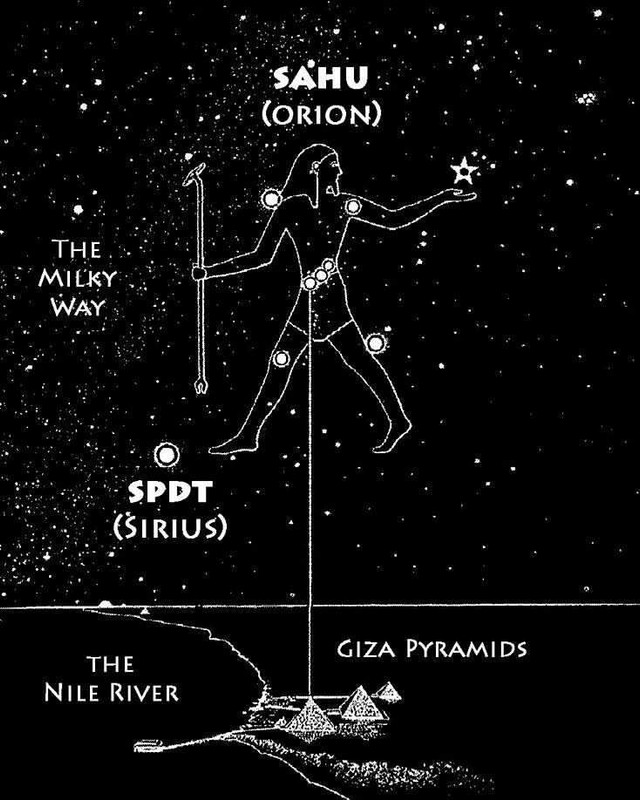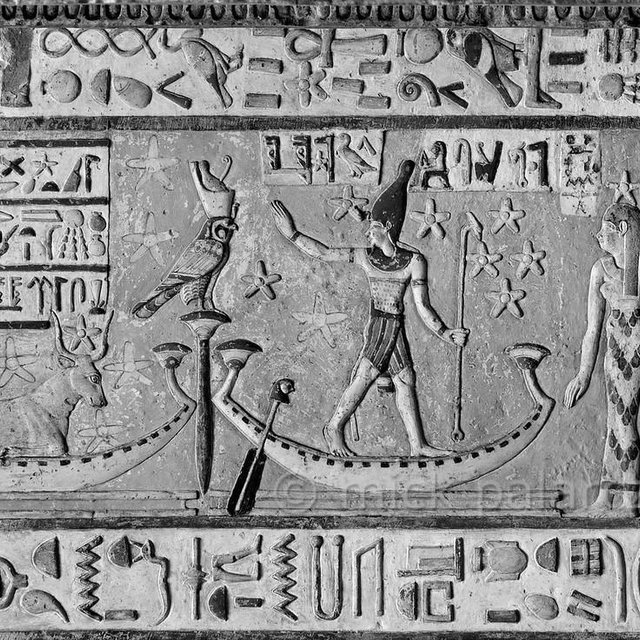
Izanagi and Izanami, (Japanese: “He Who Invites” and “She Who Invites”) in full Izanagi no Mikoto and Izanami no Mikoto, the central deities (kami) in the Japanese creation myth. They were the eighth pair of brother-and-sister gods to appear after heaven and earth separated out of chaos. By standing on the floating bridge of heaven and stirring the primeval ocean with a heavenly jeweled spear, they created the first landmass.
The two decided that they wished to unite—often interpreted as marriage—but their first attempt at sexual union resulted in a deformed child, Hiruko (“Leech Child,” known in later Shintō mythology as the god Ebisu), and they set him adrift in a boat. Attributing the mistake to a ritual error on the part of Izanami, who, as a woman, should never have spoken first, they began again and produced numerous islands and deities. In the act of giving birth to the fire god, Kagutsuchi (or Homusubi), Izanami was fatally burned and went to Yomi, the land of darkness. The grief-stricken Izanagi followed her there, but she had eaten the food of that place and could not leave. She became angry when he lit a fire and saw her rotting and covered with maggots. A horrified Izanagi fled, with a host of women and then Izanami herself in pursuit. After reaching the entrance to Yomi, Izanagi placed a stone across it, thus sealing in Izanami and breaking their union.
Izanagi bathed in the sea to purify himself from contact with the dead. As he bathed, a number of deities came into being.
The sun goddess Amaterasu was born from his left eye, the moon god Tsukiyomi was born from his right eye, and the storm god Susanoo was born from his nose.

In the Shintō religion, Izanagi’s bath is regarded as the founding of harai, the important ritual purification practices of Shintō.
Amaterasu, in full Amaterasu Ōmikami, (Japanese: “Great Divinity Illuminating Heaven”), the celestial sun goddess from whom the Japanese imperial family claims descent, and an important Shintō deity. She was born from the left eye of her father, Izanagi, who bestowed upon her a necklace of jewels and placed her in charge of Takamagahara (“High Celestial Plain”), the abode of all the kami. One of her brothers, the storm god Susanoo, was sent to rule the sea plain. Before going, Susanoo went to take leave of his sister. As an act of good faith, they produced children together, she by chewing and spitting out pieces of the sword he gave her, and he by doing the same with her jewels. Susanoo then began to behave very rudely—he broke down the divisions in the rice fields, defiled his sister’s dwelling place, and finally threw a flayed horse into her weaving hall. Indignant, Amaterasu withdrew in protest into a cave, and darkness fell upon the world.
The other 800 myriads of gods conferred on how to lure the sun goddess out. They collected cocks, whose crowing precedes the dawn, and hung a mirror and jewels on a sakaki tree in front of the cave. The goddess Amenouzume (q.v.) began a dance on an upturned tub, partially disrobing herself, which so delighted the assembled gods that they roared with laughter. Amaterasu became curious how the gods could make merry while the world was plunged into darkness and was told that outside the cave there was a deity more illustrious than she. She peeped out, saw her reflection in the mirror, heard the cocks crow, and was thus drawn out from the cave. The kami then quickly threw a shimenawa, or sacred rope of rice straw, before the entrance to prevent her return to hiding.
Amaterasu’s chief place of worship is the Grand Shrine of Ise, the foremost Shintō shrine in Japan. She is manifested there in a mirror that is one of the three Imperial Treasures of Japan (the other two being a jeweled necklace and a sword). The genders of Amaterasu and her brother the moon god Tsukiyomi no Mikato are remarkable exceptions in worldwide mythology of the sun and the moon. See also Ukemochi no Kami.



The word tsunami (pronounced tsoo-nah'-mee) is composed of the Japanese words "tsu" (which means harbor) and "nami" (which means "wave").




Depiction of Susanoo, God of Storms and Sea
Sahu (or sao, or Sah, or Sahoo, or Shahu). is a surname found in India. The meaning of the term "Sahu" may change from region to region. The term generally means "businessman" or "moneylender". It means "gentle" in the Jhelum region and "patient" among Jats. - Google search for "sahu meaning".

Sahu/Orion depicted at Dendera

Susanoo's name is variously given in the Kojiki as 'Takehaya-Susanoo-no-Mikoto' (建速須佐之男命), 'Haya-Susanoo-no-Mikoto' (速須佐之男命), or simply as 'Susanoo-no-Mikoto' (須佐之男命). He is meanwhile named in the Nihon Shoki as 'Susanoo-no-Mikoto' (素戔嗚尊), 'Kamu-Susanoo-no-Mikoto' (神素戔嗚尊), 'Haya-Susanoo-no-Mikoto' (速素戔嗚尊), and 'Take-Susanoo-no-Mikoto' (武素戔嗚尊). The Fudoki of Izumo Province renders his name both as 'Kamu-Susanoo-no-Mikoto' (神須佐能袁命) and 'Susanoo-no-Mikoto' (須佐能乎命). In these texts the following honorific prefixes are attached to his name: take- (建/武, "brave"), haya- (速, "swift"), and kamu- (神, "divine").
The susa in Susanoo's name has been variously explained as being derived from either of the following words:
The verb susabu or susamu meaning 'to be impetuous,' 'to be violent,' or 'to go wild'
The verb susumu, 'to advance'
The township of Susa (須佐郷) in Iishi District, Izumo Province (modern Shimane Prefecture)
A word related to the Middle Korean 'susung', meaning 'master' or 'shaman'

No comments:
Post a Comment
Note: Only a member of this blog may post a comment.